Effect of the Granularity of Cubic Boron Nitride Vitrified Grinding Wheels on the Planar Technical Blades Sharpening Process
Abstract
1. Introduction
- factors conducive to strong corrosive interactions (including a humid work environment, the use of alkaline compounds and phosphates to decontaminate and protect the raw material from microorganisms and the use of nitric and phosphoric acid to remove post-production sludge);
- factors that promote mechanical wear, mainly the change in the geometry of the cutting edges of blades because of the machining process (e.g., dulling of cutting edges);
- factors that promote a change in the properties of the material, leading to an increase in its susceptibility to deformation.
2. Materials and Methods
- grinding wheel grain size (cBN grain number according to Federation of European Producers of Abrasives standards: B126, B181 and B251),
- process kinematics (grinding with the circumference of the wheel; grinding with the face of the wheel; grinding with the conical surface of the wheel),
- and feed rate (vf = 100; 150; 200 mm/min), on the results of the grinding evaluated by the cutting force of the blade after machining F, blade surface texture parameters as well as blade surface morphology indicated by microscopic observation.
- arithmetic mean deviation of the surface Sa;
- total height of the surface St;
- mean void volume ratio Smvr;
- density of summits of the surface Sds;
- texture aspect ratio of the surface Str;
- root-mean-square slope of the surface Sdq;
- developed interfacial area ratio Sdr;
- bearing index Sbi.
3. Results and Discussion
- the cutting force F recorded during the test of cutting through the test specimen with the knife after sharpening on a special test stand (Section 3.1);
- the values of selected surface texture parameters: Sa, St, Smvr, Str, Sdq, Sdr and Sbi (Section 3.2);
- an analysis of the morphology of the blade surface after grinding assessed by microscopic observations (Section 3.3).
3.1. Analysis of Cutting Force Values F
3.2. Analysis of the Blade Surface Texture
3.3. Analysis of the Blade Surface Morphology
4. Conclusions
- The results of the measurements showed that the blade surfaces shaped with grinding wheels made of cBN grains numbered B126 required the use of the relatively highest force values to cut the test specimens: the total value determined from all tests (18.62 N) was about 19% higher with respect to the total cutting force values obtained for blades ground with grinding wheels made of cBN grains numbered B181 (15.67 N) and B251 (15.72 N).
- The microtopographs of the blade surfaces clearly showed regular machining traces oriented according to the direction of movement of active abrasive grains on the grinding wheel surface and resulting from the combination of the rotational and feed motion of the tool.
- Surface texture microtopographs also revealed local defects (single vertices) and scratches, occurring mainly on the surface of blades shaped with an abrasive wheel with B126 (blade #1–3) and B251 (blade #7–9) grains.
- The differences between the values of surface texture parameters calculated for the surfaces shaped by the three types of grinding wheels compared (B121, B181 and B251) were relatively small. However, considering the values of the bearing index Sbi, a grinding wheel with B181 grains was selected as the wheel that allowed the shaping of a blade surface with the most favorable functional characteristics.
- An analysis of microscopic images of the blade surface of planar knives confirmed the characteristic features of the blades’ surfaces, previously found based on the analysis of their microtopography. Few surface defects in the form of cracks oriented in a direction different from the dominant one were observed on the microscopic images, which may be the result of the procedure of removing the rewind of the blade. Microscopic images also presented a few irregular pits in the shaped surface occurring most abundantly on the surface of blades ground with the B251 grinding wheel.
- Considering the overall results of the cutting force F value measurements, surface texture analysis and microscopic observations, it was found that grinding wheels made of cBN grains of B181 (of the granularity included in the study) were most favorable for shaping the planar technical blades of X39Cr13 steel in the grinding process.
Author Contributions
Funding
Institutional Review Board Statement
Informed Consent Statement
Data Availability Statement
Conflicts of Interest
References
- Sen, D.P. Advances in Fish Processing Technology; Allied Publishers: New Dehli, India, 2005. [Google Scholar]
- Boziaris, I.S. (Ed.) Seafood Processing: Technology, Quality and Safety; John Wiley & Sons: Chichester, UK, 2013. [Google Scholar]
- Borda, D.; Nicolau, A.I.; Raspor, P. Trends in Fish Processing Technologies; CRC Press: Boca Raton, FL, USA, 2017. [Google Scholar]
- Hall, G.M. (Ed.) Fish Processing: Sustainability and New Opportunities; John Wiley & Sons: New York, NY, USA, 2011. [Google Scholar]
- Hall, G.M. Fish Processing Technology, 2nd ed.; Springer Science & Business Media: London, UK, 2012. [Google Scholar]
- Colás, R.; Totten, G.E. Encyclopedia of Iron, Steel, and Their Alloys; CRC Press: New York, NY, USA, 2016. [Google Scholar]
- Krejcie, A.J.; Kapoor, S.G.; Devor, R.E. A hybrid process for manufacturing surgical-grade knife blade cutting edges from bulk metallic glass. J. Manuf. Process. 2012, 14, 26–34. [Google Scholar] [CrossRef]
- Jackson, M.J.; Davim, J.P. (Eds.) Machining with Abrasives; Springer Science + Business Media: New York, NY, USA, 2010. [Google Scholar]
- Klocke, F. Manufacturing Processes 2: Grinding, Honing, Lapping; Springler: Berlin/Heidelberg, Germany, 2009. [Google Scholar]
- Marinescu, I.D.; Rowe, W.B.; Dimitrov, B.; Inasaki, I. Tribology of Abrasive Machining Processes; William Andrew Publishing: Norwich, NY, USA, 2004. [Google Scholar]
- Marinescu, I.D.; Hitchiner, M.; Uhlmann, E.; Rowe, W.B.; Inasaki, I. Handbook of Machining with Grinding Wheels; CRC Press: Boca Raton, FL, USA, 2007. [Google Scholar]
- Rowe, W.B. Principles of Modern Grinding Technology; William Andrew: Burlington, NJ, USA, 2009. [Google Scholar]
- Herman, D. Glass and glass-ceramic binder obtained from waste material for binding alundum abrasive grains into grinding wheels. Ceram. Int. 1998, 24, 515–520. [Google Scholar] [CrossRef]
- Herman, D.; Markul, J. Influence of microstructures of binder and abrasive grain on selected operational properties of ceramic grinding wheels made of alumina. Int. J. Mach. Tools Manuf. 2004, 44, 511–522. [Google Scholar] [CrossRef]
- Herman, D.; Plichta, J.; Nadolny, K. New ceramic abrasive tools for rough and finishing grinding in one pass. Mater. Sci. Forum 2006, 526, 163–168. [Google Scholar] [CrossRef]
- Zieliński, B.; Kapłonek, W.; Sutowska, M.; Nadolny, K. Analysis of a Feasibility Study of a Precision Grinding Process for Industrial Blades Used in the Cutting of Soft Tissues by a Prototype 5-Axis CNC Grinding Machine. Appl. Sci. 2019, 9, 3883. [Google Scholar] [CrossRef]
- Inter-Diament: Vitrified Bonded CBN Grinding Wheels. Available online: https://www.inter-diament.com.pl/english/vitrified_bonded_cbn_grinding_wheels (accessed on 12 July 2022).
- Zieliński, B.; Chaciński, T.; Pimenov, D.Y.; Nadolny, K. Methodology for Evaluating the Cutting Force of Planar Technical Blades Used in Flatfish Processing. Micromachines 2021, 12, 1516. [Google Scholar] [CrossRef] [PubMed]
- Kapłonek, W.; Ungureanu, M.; Nadolny, K.; Sutowski, P. Stylus profilometry in surface roughness measurements of the vertical conical mixing unit used in a food industry. J. Mech. Eng. 2017, 47, 1–8. [Google Scholar] [CrossRef][Green Version]
- Nadolny, K.; Kapłonek, W.; Sutowska, M.; Sutowski, P.; Myśliński, P.; Gilewicz, A. Experimental Studies on Durability of PVD-Based CrCN/CrN-Coated Cutting Blade of Planer Knives Used in the Pine Wood Planing Process. Materials 2020, 13, 2398. [Google Scholar] [CrossRef] [PubMed]
- Nadolny, K.; Kapłonek, W.; Sutowska, M.; Sutowski, P.; Myśliński, P.; Gilewicz, A.; Warcholiński, B. Experimental tests of PVD AlCrN-coated planer knives on planing Scots pine (Pinus sylvestris L.) under industrial conditions. Eur. J. Wood Wood Prod. 2021, 79, 645–665. [Google Scholar] [CrossRef]
- Nadolny, K.; Kapłonek, W.; Sutowska, M.; Sutowski, P.; Myśliński, P.; Gilewicz, A.; Warcholiński, B. Moving towards sustainable manufacturing by extending the tool life of the pine wood planing process using the AlCrBN coating. Sustain. Mater. Technol. 2021, 28, e00259. [Google Scholar] [CrossRef]
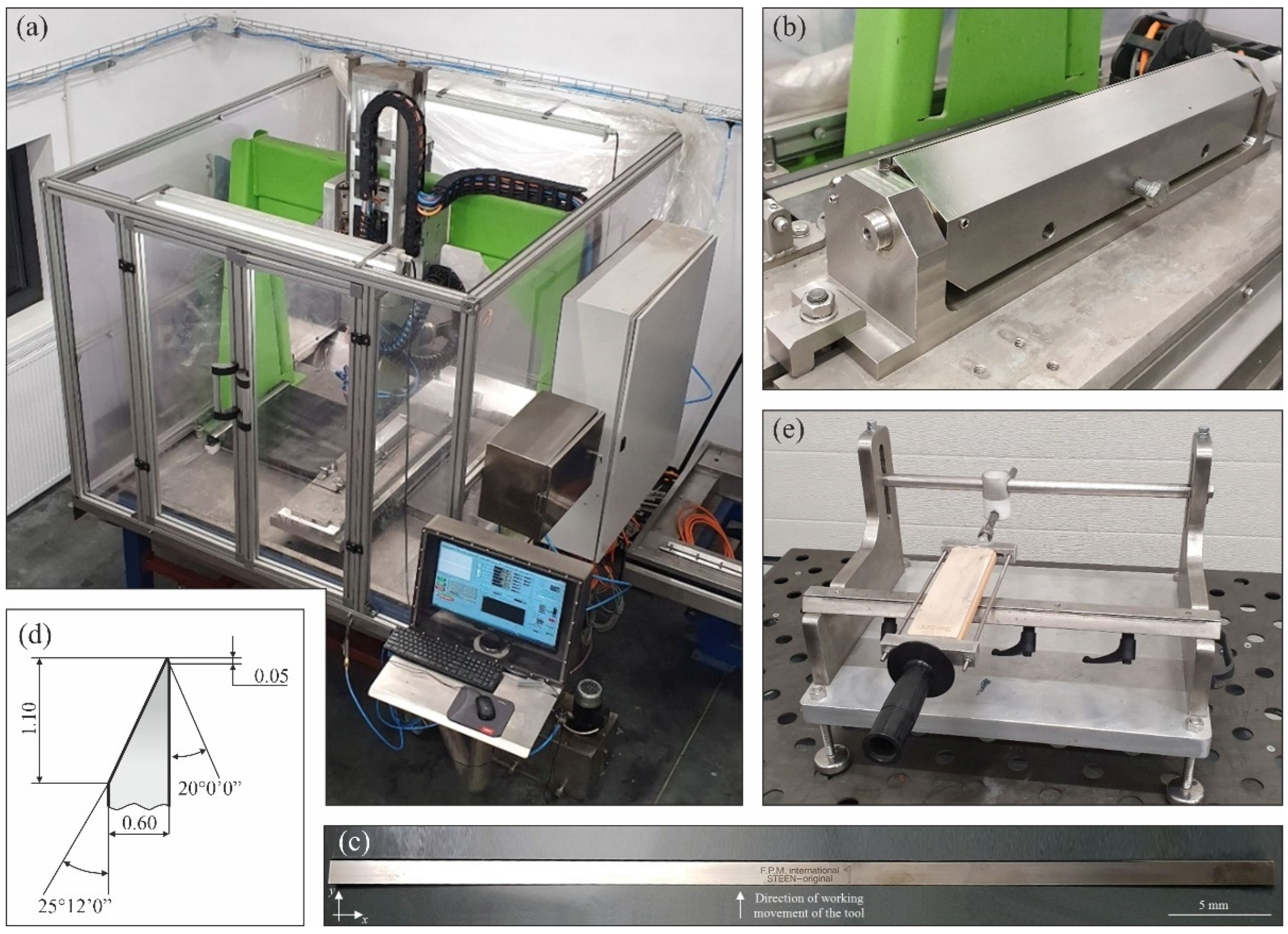
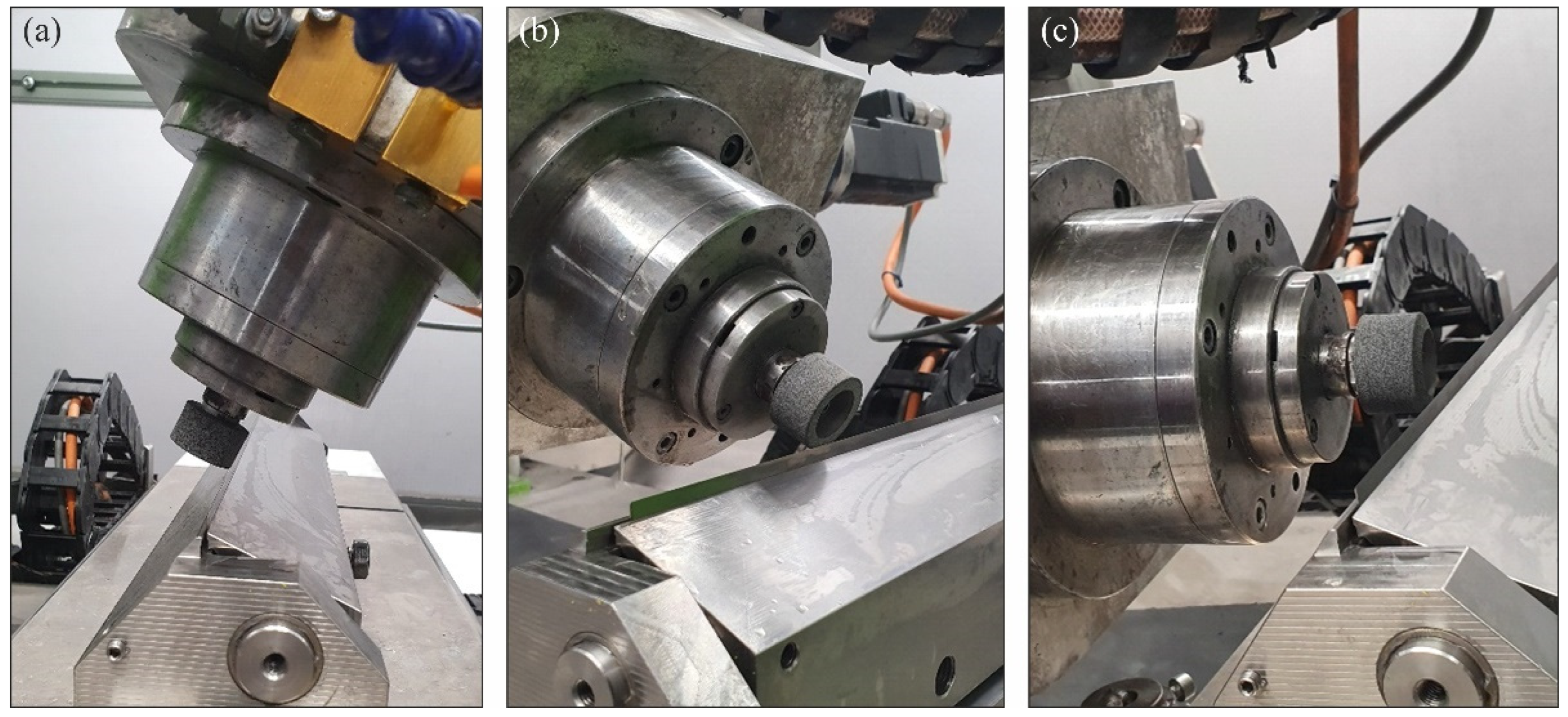
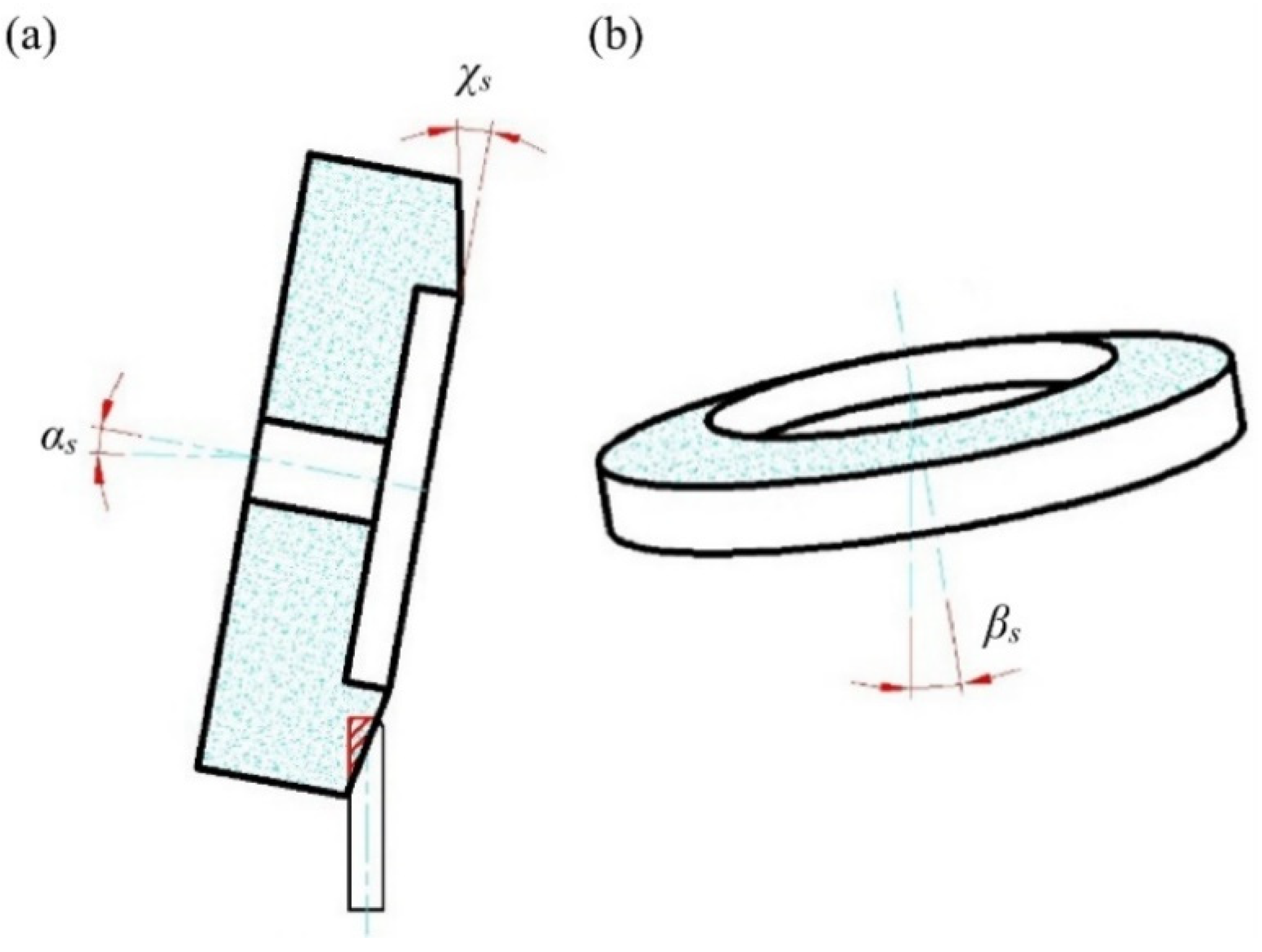
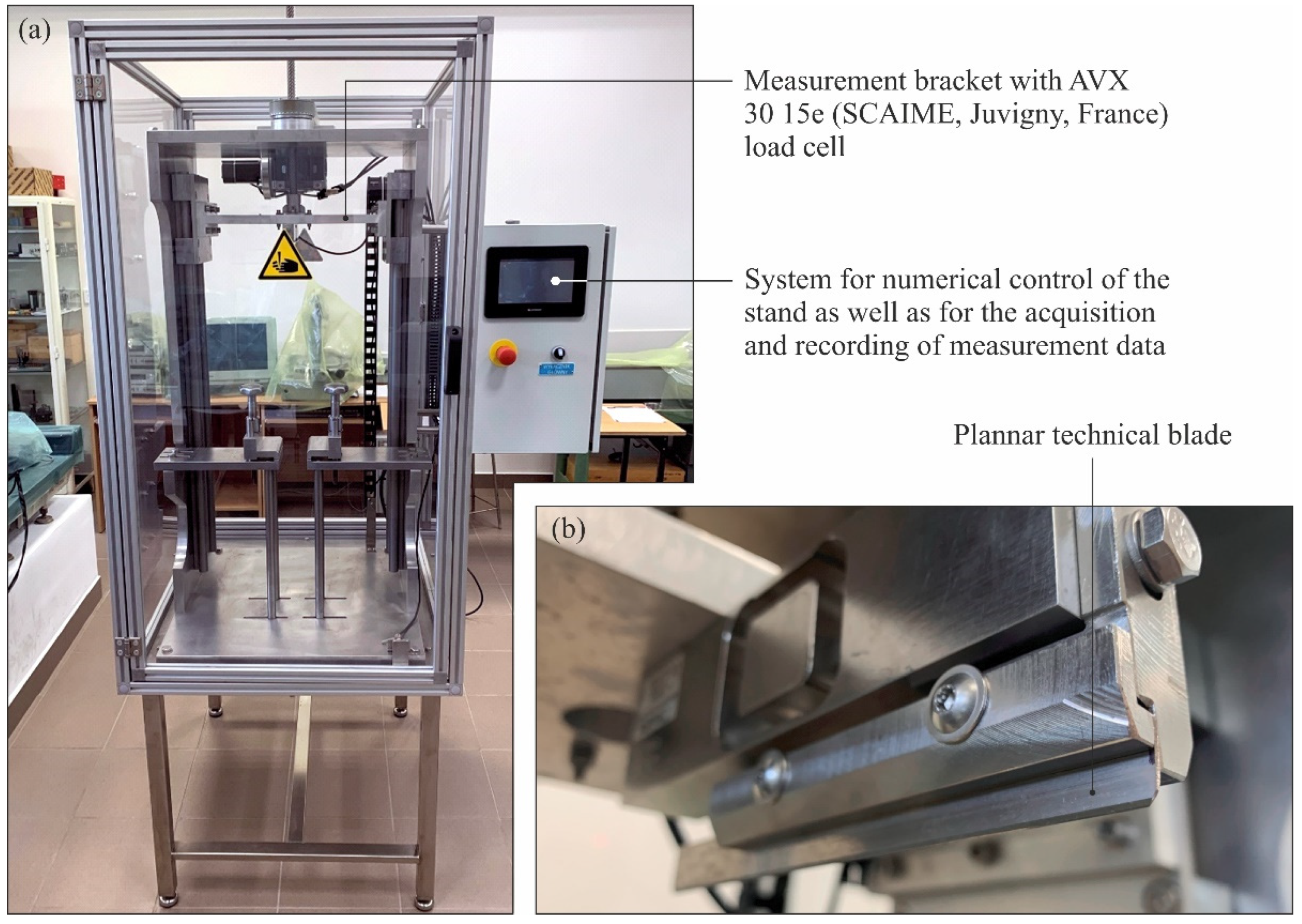


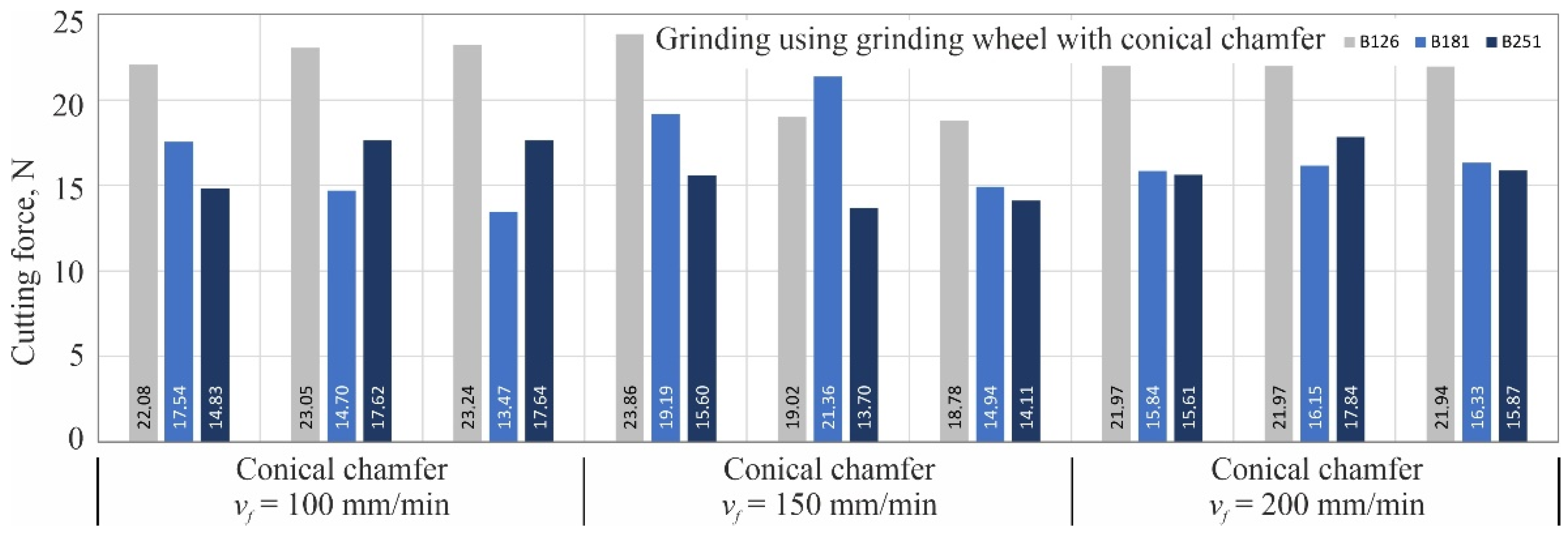
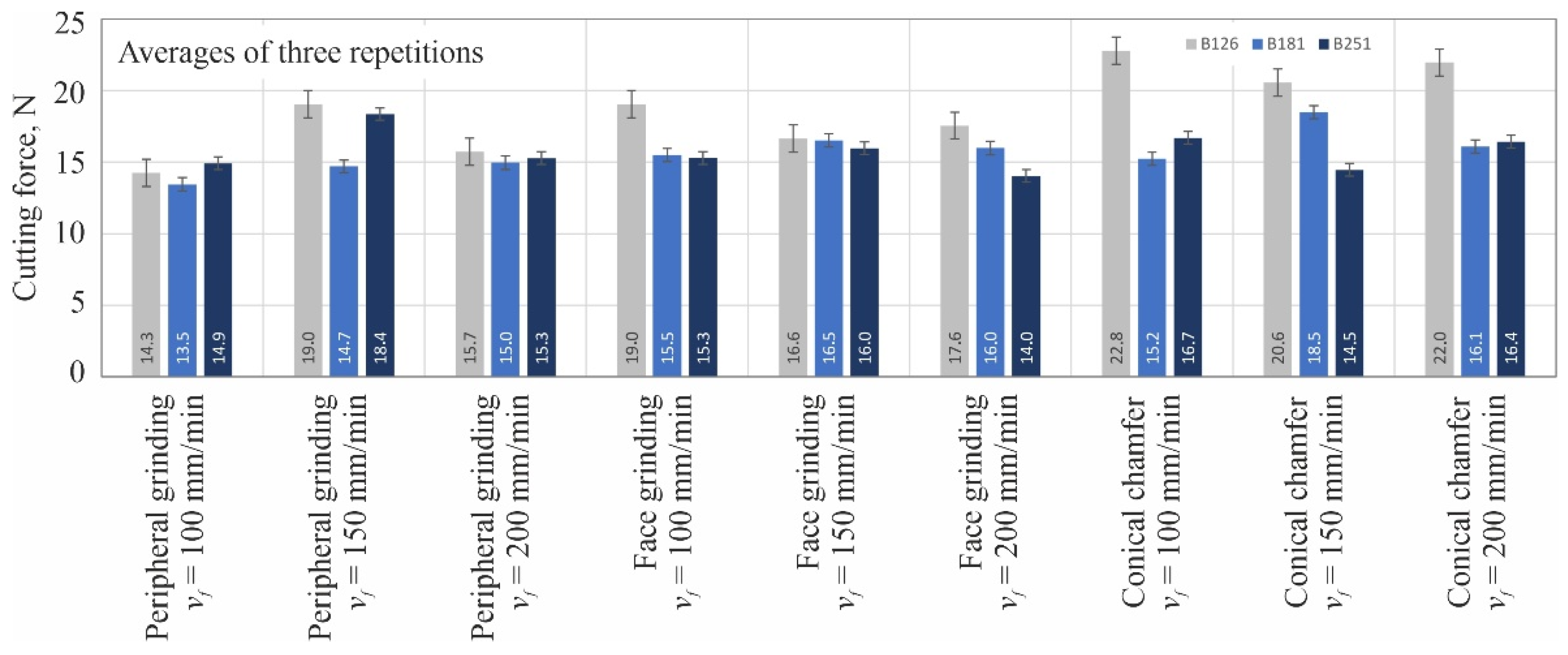
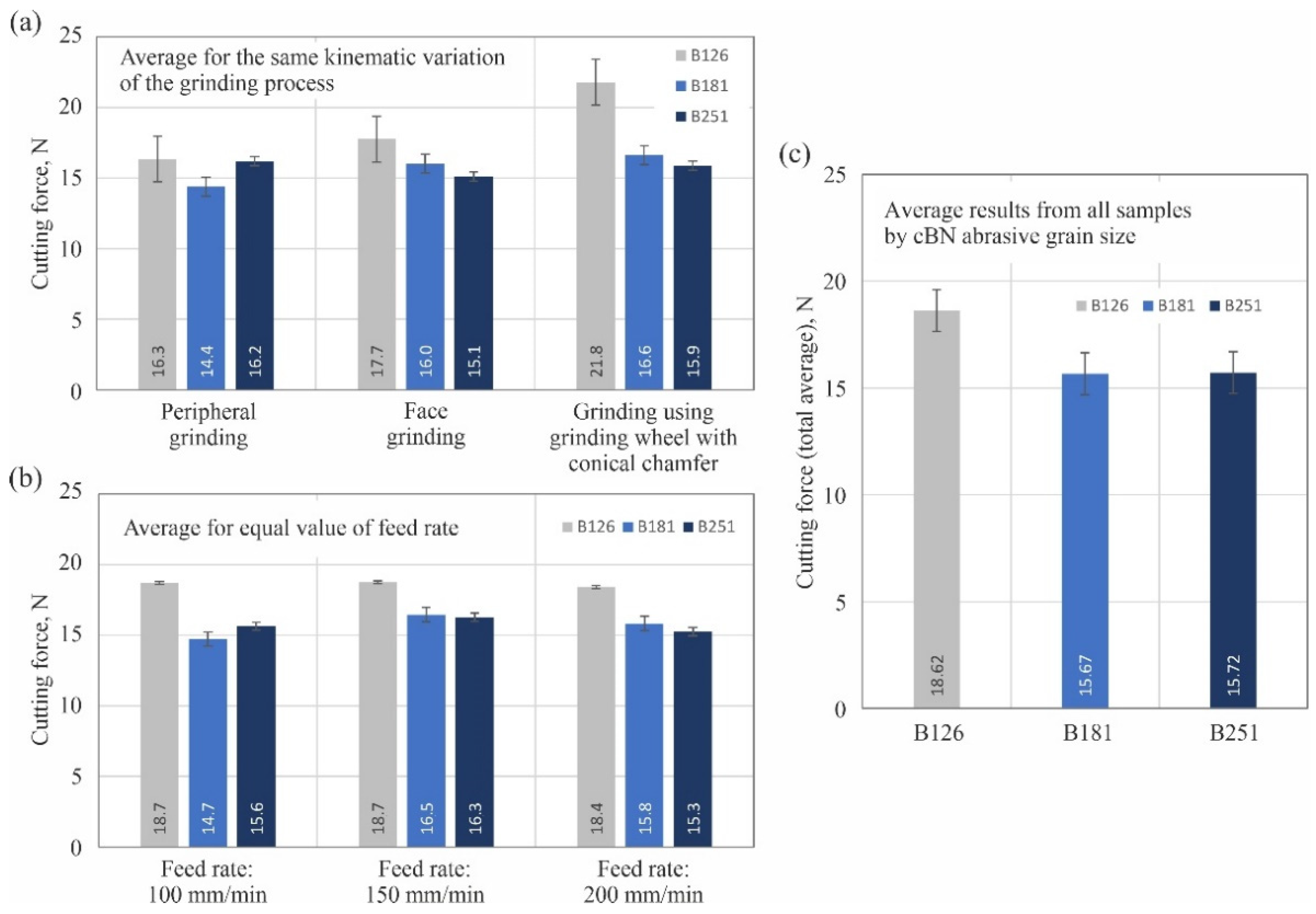
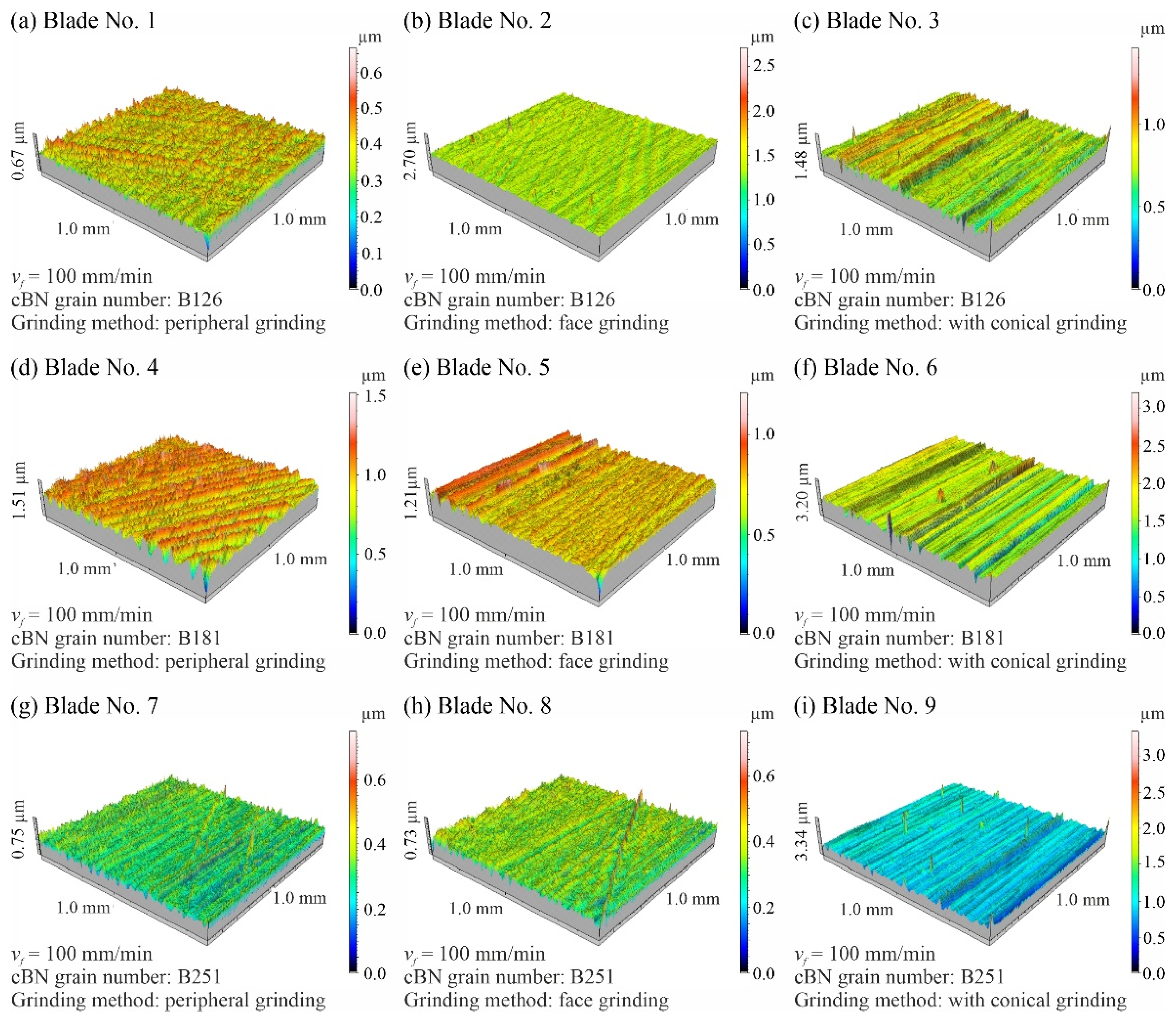

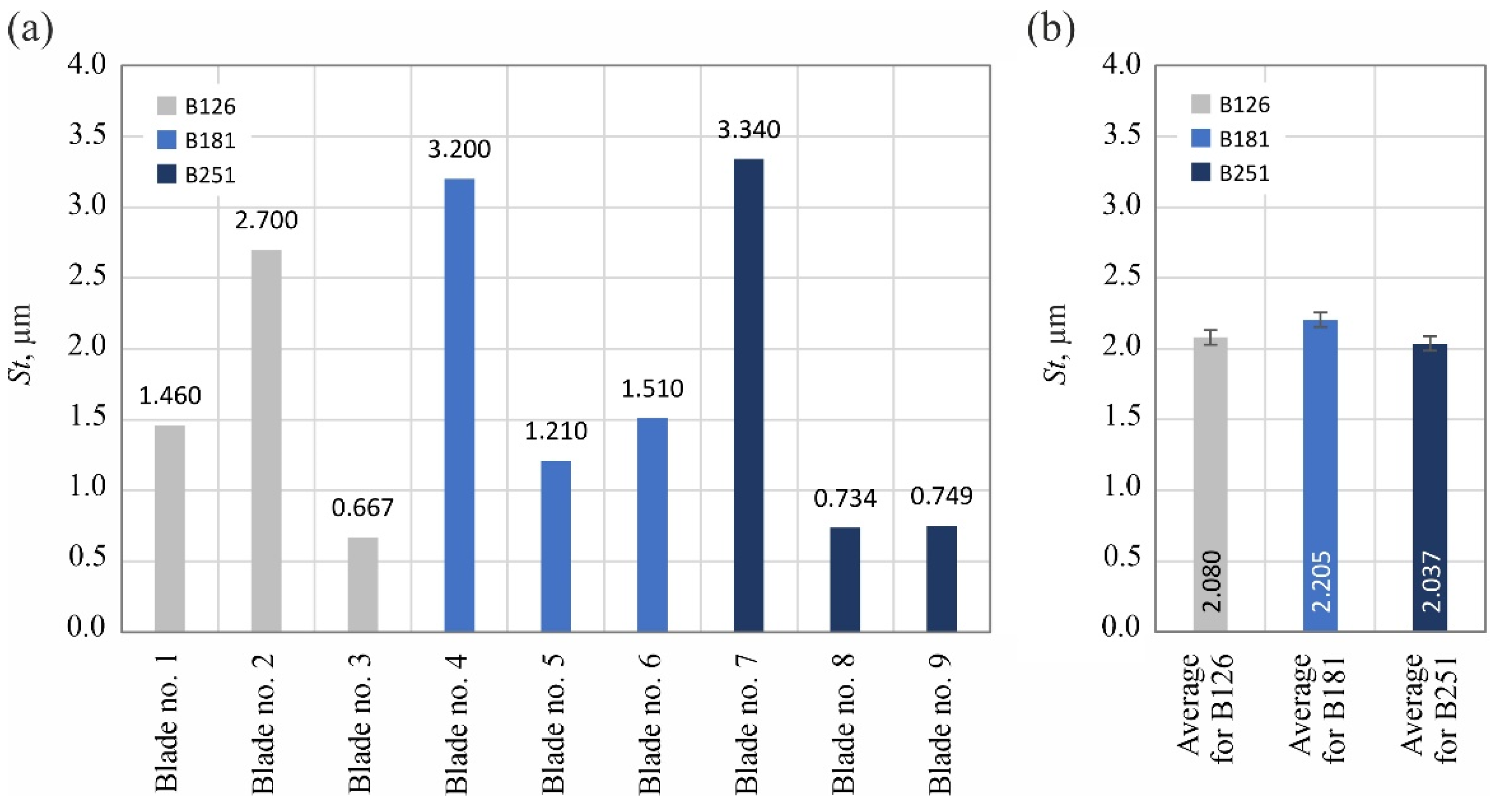
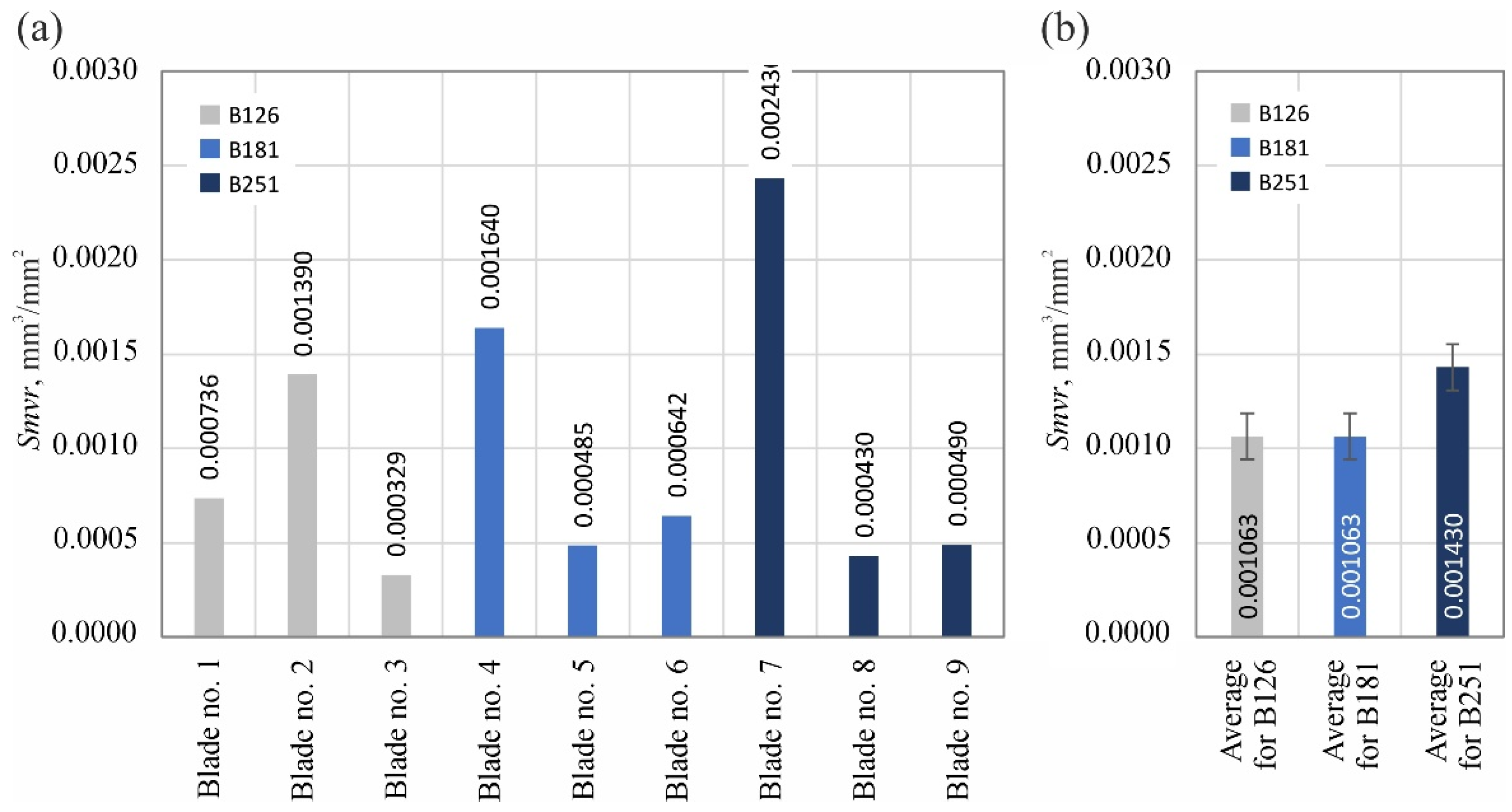

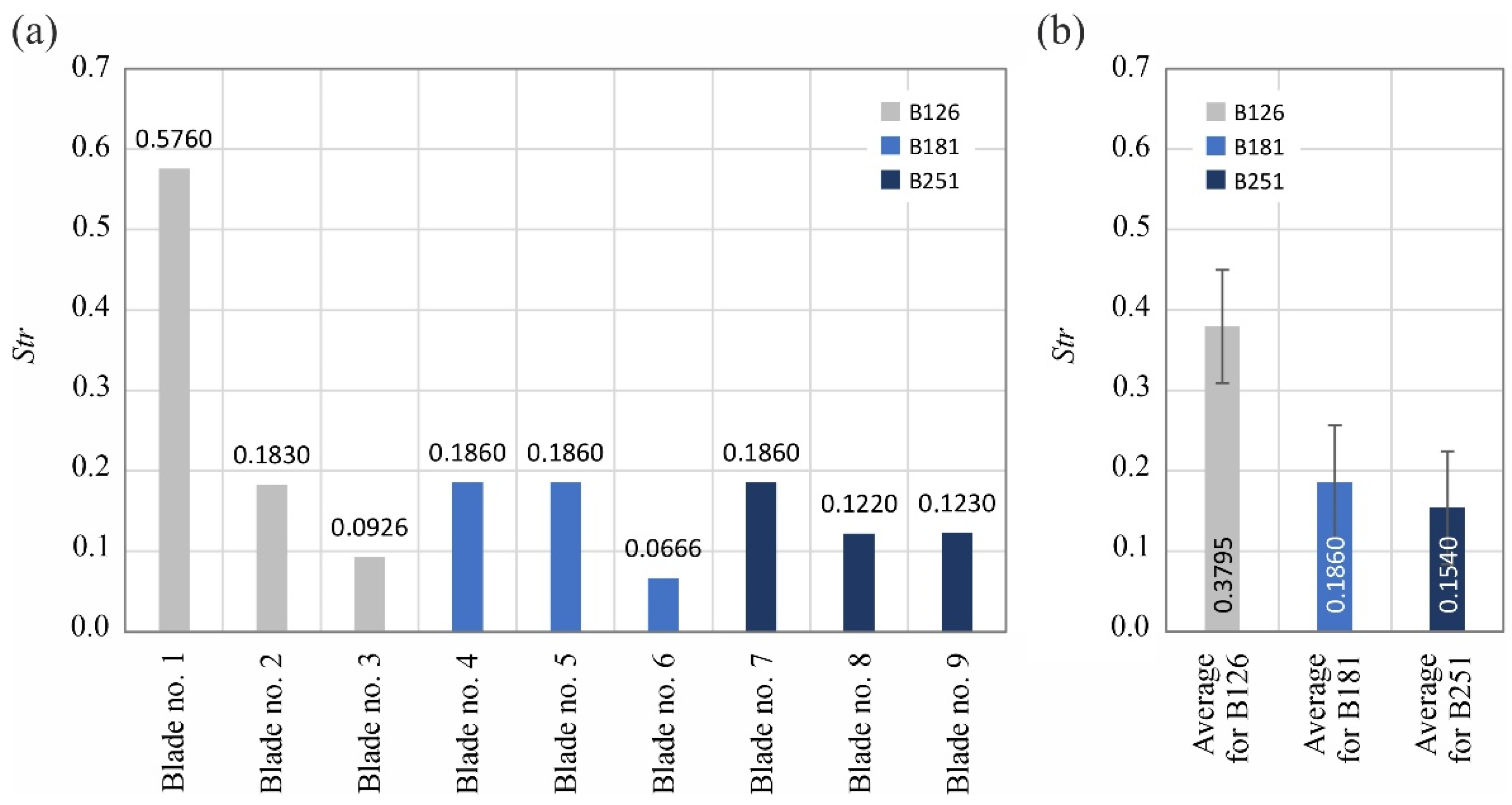
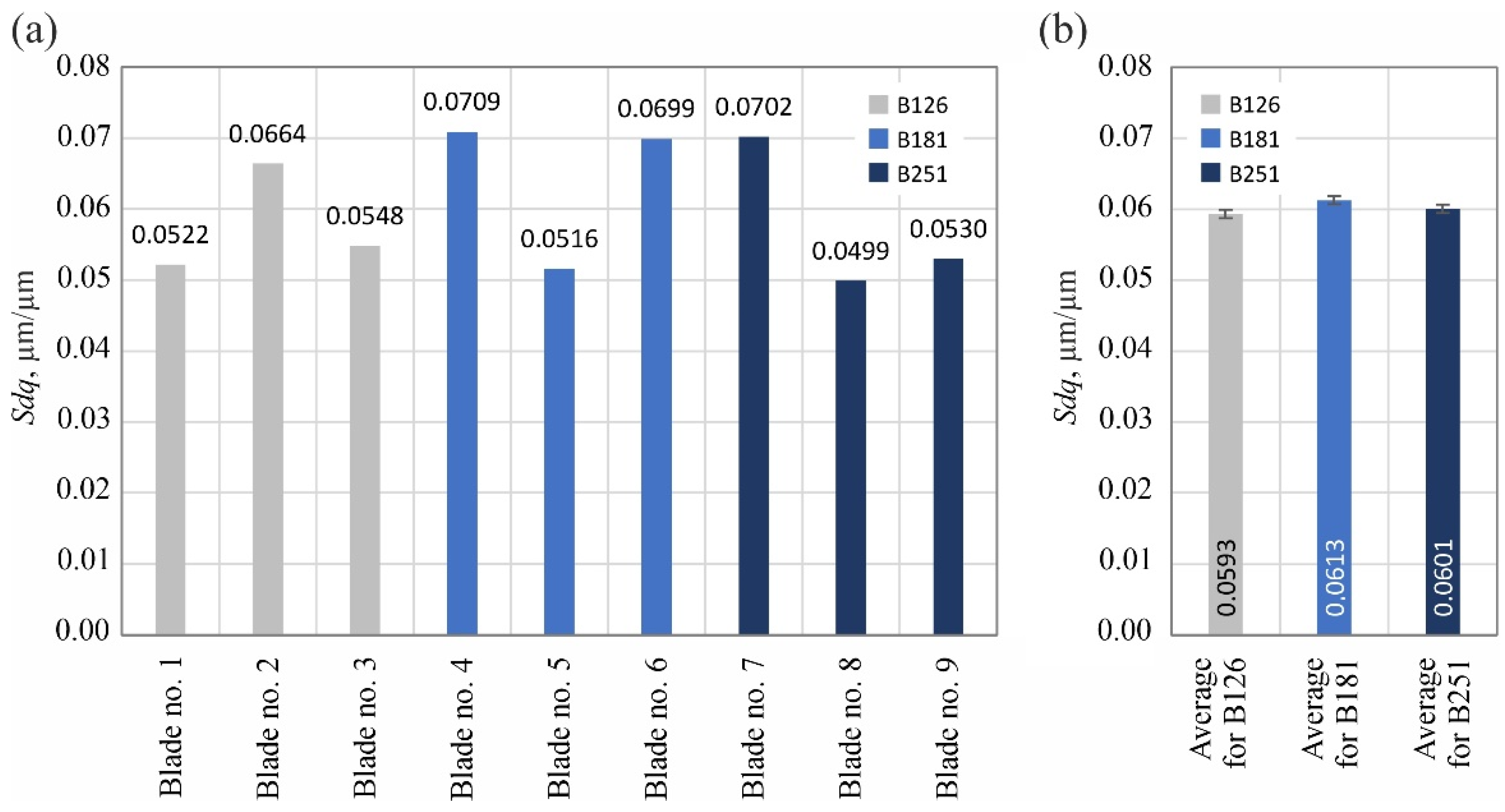
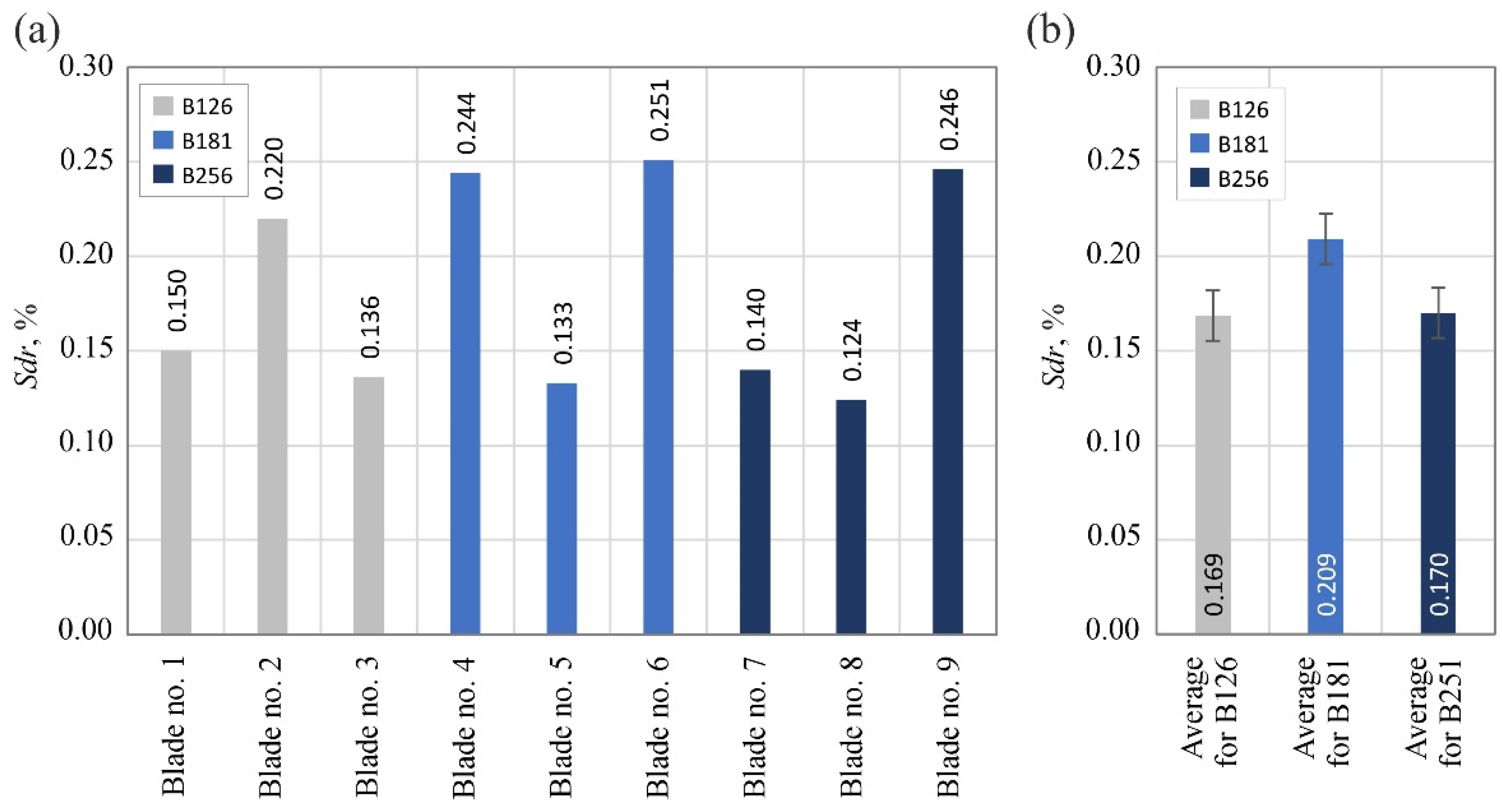
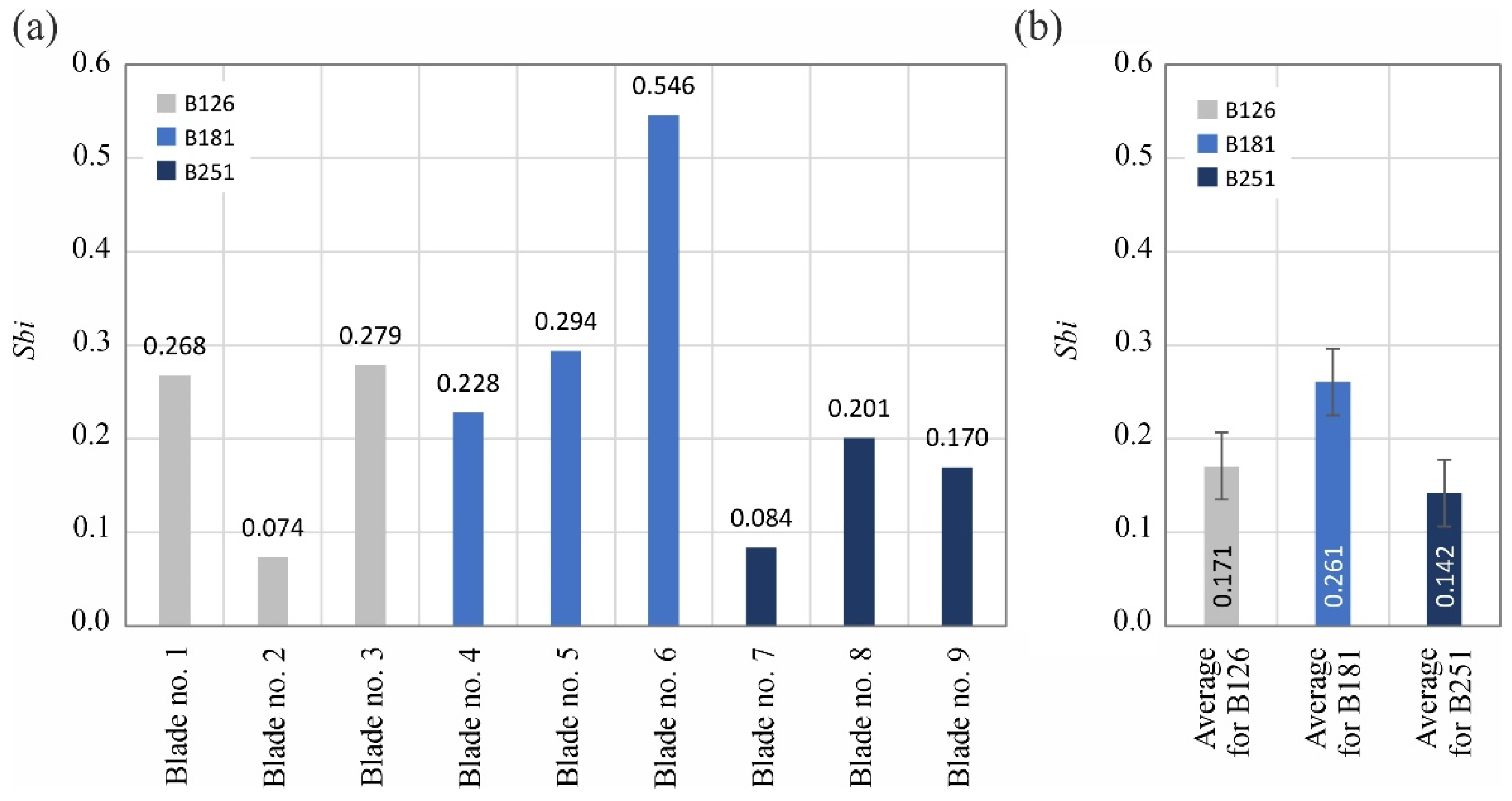
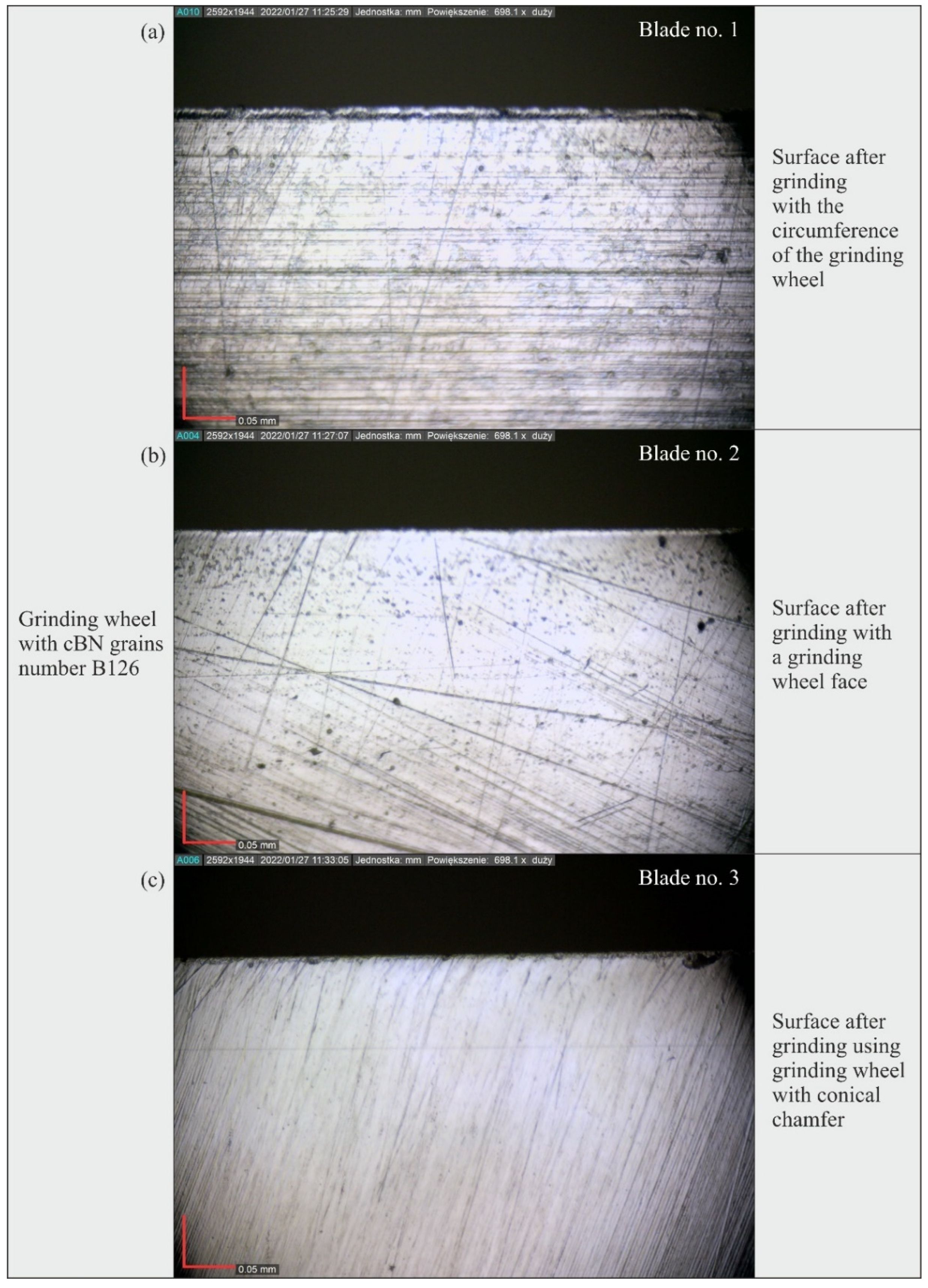
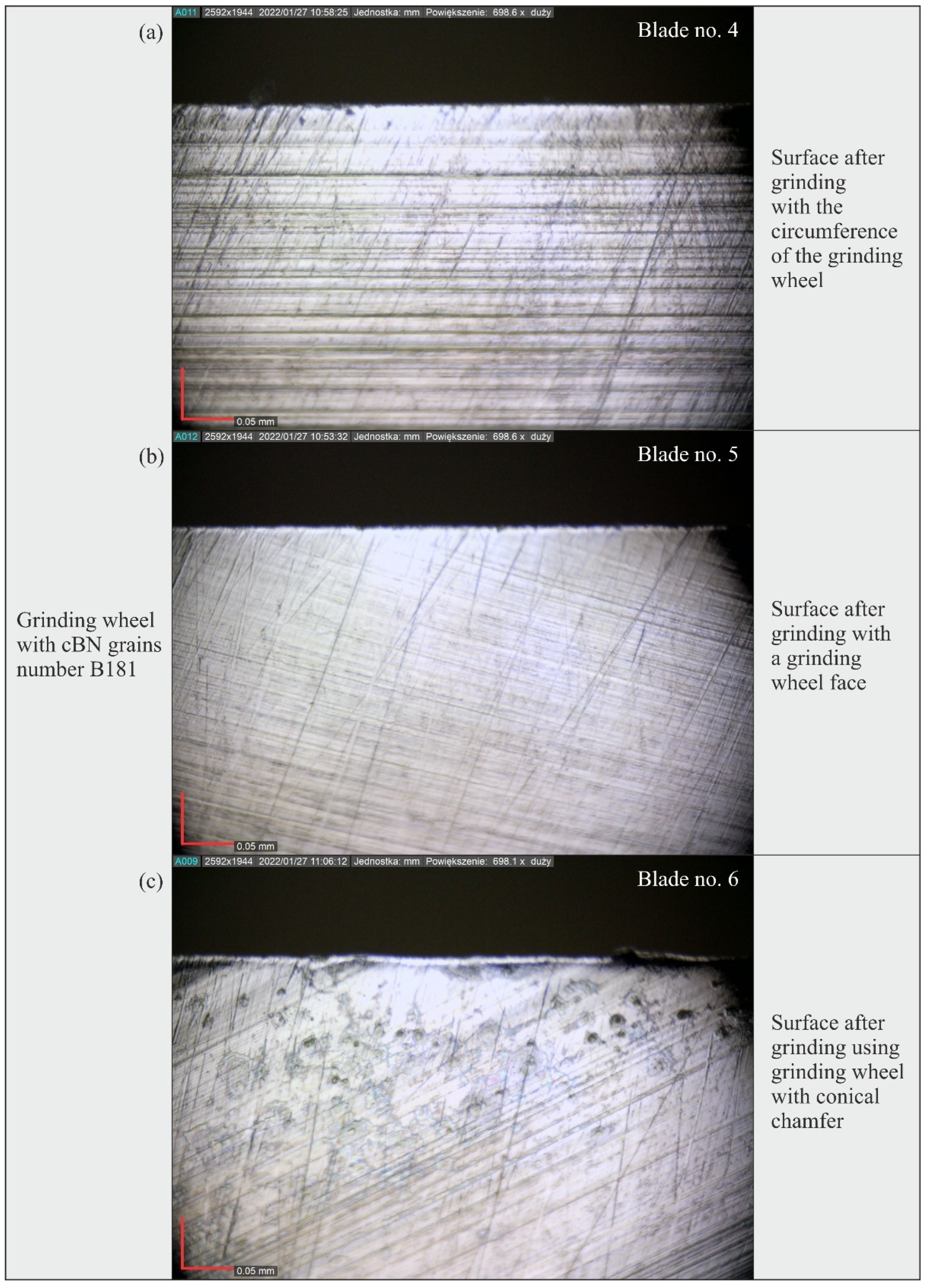

| Full Name | Cubic Boron Nitride (cBN) |
|---|---|
| Chemical composition | ~43.6% B ~56.4% N |
| Size of the crystal | From ~10 μm (monocrystalline) to <1 μm (microcrystalline) |
| Shape | Blocky (hexagonal) or irregular, very sharp |
| Specific density | 3.48 g/cm3 |
| Knoop HK hardness | 42–54 GPa |
| Critical stress intensity factor KIc | 3.7 MPa·m1/2 |
| Coefficient of friction (hardened steel) | 0.19 |
| Thermal conductivity coefficient λ | 240–1300 W/m·K |
| Designation | Dimensions | Composition | |||||||
|---|---|---|---|---|---|---|---|---|---|
| D, mm | P, mm | T, mm | H, mm | F, mm | Grain Size According to FEPA, µm | Grain Concentration, Carat/cm3 | Degree of Hardness | Bond | |
| 5A1 35 × 25 × 10/22 × 15 B181 V240 SV | 35 | 22 | 25 | 10 | 15 | 180/150 | 4.18 | Medium | Vitrified |
| 5A1 35 × 25 × 10/22 × 15 B181 V240 SV | 35 | 22 | 25 | 10 | 15 | 180/150 | 4.18 | Medium | Vitrified |
| 5A1 35 × 25 × 10/22 × 15 B251 V240 SV | 35 | 22 | 25 | 10 | 15 | 250/212 | 4.18 | Medium | Vitrified |
| Diagram of grinding wheel construction with designations of basic dimensions | 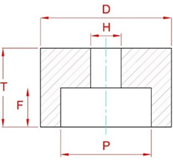 | ||||||||
| FEPA Grain Number | FEPA Grain Size | Grain Size US Standard ASTM E-11 |
|---|---|---|
| B126 | 125/106 µm | 120/140 mesh |
| B181 | 180/150 µm | 80/100 mesh |
| B251 | 250/212 µm | 60/70 mesh |
| Process | Rectilinear Grinding of Flat Surfaces | |
|---|---|---|
| Test stand | Specialized five-axis CNC grinding machine for shaping knife blades with low rigidity | |
| Workpiece | Planar knives designed for the process of skinning flat fish made of high-carbon martensitic X39Cr13 stainless steel (Kuno Wasser GmbH, Solingen, Germany for Steen F.P.M. International, Kalmthout, Belgium) | |
| Grinding wheel | 5A1 35 × 25 × 10/22 × 15 B126 V240 SV; 5A1 35 × 25 × 10/22 × 15 B181 V240 SV; 5A1 35 × 25 × 10/22 × 15 B251 V240 SV (INTER-DIAMENT, Grodzisk Mazowiecki, Poland) | |
| Dressing parameters of the grinding wheel | Dresser: M1039/D 1.00 ct (Dialeks, Pruszków, Poland) Rotational speed of grinding wheel in dressing: nsd = 32,000 rpm Feed rate during dressing: vfd = 0.00165 m/s Dressing allowance: ad = 0.03 mm Number of dressing passes: id = 2 | |
| Grinding parameters | Constant input quantities | Variable input quantities |
| Rotational speed of grinding wheel: ns = 32,000 rpm Allowance for rough passage: ae rough = 0.10 mm Number of roughing passes for both phases of the blade: 1 Allowance for sparking-out passage: ae sparking-out = 0.02 mm Number of sparking-out passes for both phases of the blade: 1 Direction of rotation of the grinding wheel: right–in the direction of the axis of symmetry of the knife (to the blade) Angular positioning of the grinding wheel while grinding with the circumference of the wheel: αs = 25°, βs = 0°, χs = 0° Angular positioning of the grinding wheel while grinding with the face of the wheel: αs = 65°, βs = 0°, χs = 0° Angular positioning of the grinding wheel while grinding with the conical surface of the wheel: αs = 85°, βs = 5°, χs = 20° | Grinding wheels: 5A1 35 × 25 × 10/22 × 15 B126 V240 SV (Abbreviated designation: B126) 5A1 35 × 25 × 10/22 × 15 B181 V240 SV (Abbreviated designation: B181) 5A1 35 × 25 × 10/22 × 15 B251 V240 SV (Abbreviated designation: B251) Grinding kinematics: grinding with the circumference of the wheel; grinding with the face of the wheel; grinding with the conical surface of the wheel Longitudinal feed velocity of the grinding wheel: vf = 100; 150; 200 mm/min | |
| Cooling conditions | Flooding (WET) cooling using a low-pressure circular nozzle with expenditure Q = 1.75 dm3/min. Coolant: 5% water–oil emulsion of Cimtech® M26 oil by CIMCOOL® Fluid Technology forming part of Milacron LLC (Cincinnati, OH, USA) | |
Publisher’s Note: MDPI stays neutral with regard to jurisdictional claims in published maps and institutional affiliations. |
© 2022 by the authors. Licensee MDPI, Basel, Switzerland. This article is an open access article distributed under the terms and conditions of the Creative Commons Attribution (CC BY) license (https://creativecommons.org/licenses/by/4.0/).
Share and Cite
Zieliński, B.; Nadolny, K.; Zawadka, W.; Chaciński, T.; Stachurski, W.; Batalha, G.F. Effect of the Granularity of Cubic Boron Nitride Vitrified Grinding Wheels on the Planar Technical Blades Sharpening Process. Materials 2022, 15, 7989. https://doi.org/10.3390/ma15227989
Zieliński B, Nadolny K, Zawadka W, Chaciński T, Stachurski W, Batalha GF. Effect of the Granularity of Cubic Boron Nitride Vitrified Grinding Wheels on the Planar Technical Blades Sharpening Process. Materials. 2022; 15(22):7989. https://doi.org/10.3390/ma15227989
Chicago/Turabian StyleZieliński, Bartosz, Krzysztof Nadolny, Wojciech Zawadka, Tomasz Chaciński, Wojciech Stachurski, and Gilmar Ferreira Batalha. 2022. "Effect of the Granularity of Cubic Boron Nitride Vitrified Grinding Wheels on the Planar Technical Blades Sharpening Process" Materials 15, no. 22: 7989. https://doi.org/10.3390/ma15227989
APA StyleZieliński, B., Nadolny, K., Zawadka, W., Chaciński, T., Stachurski, W., & Batalha, G. F. (2022). Effect of the Granularity of Cubic Boron Nitride Vitrified Grinding Wheels on the Planar Technical Blades Sharpening Process. Materials, 15(22), 7989. https://doi.org/10.3390/ma15227989







